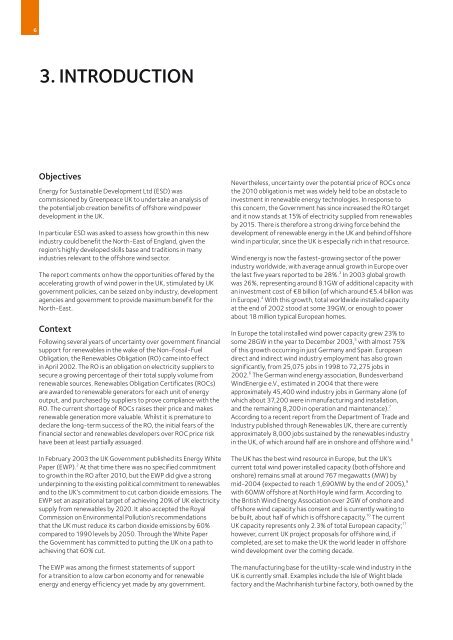offshore wind onshore jobs - a new industry for ... - Greenpeace UK
offshore wind onshore jobs - a new industry for ... - Greenpeace UK
offshore wind onshore jobs - a new industry for ... - Greenpeace UK
Create successful ePaper yourself
Turn your PDF publications into a flip-book with our unique Google optimized e-Paper software.
6<br />
3. INTRODUCTION<br />
Objectives<br />
Energy <strong>for</strong> Sustainable Development Ltd (ESD) was<br />
commissioned by <strong>Greenpeace</strong> <strong>UK</strong> to undertake an analysis of<br />
the potential job creation benefits of <strong>offshore</strong> <strong>wind</strong> power<br />
development in the <strong>UK</strong>.<br />
In particular ESD was asked to assess how growth in this <strong>new</strong><br />
<strong>industry</strong> could benefit the North-East of England, given the<br />
region’s highly developed skills base and traditions in many<br />
industries relevant to the <strong>offshore</strong> <strong>wind</strong> sector.<br />
The report comments on how the opportunities offered by the<br />
accelerating growth of <strong>wind</strong> power in the <strong>UK</strong>, stimulated by <strong>UK</strong><br />
government policies, can be seized on by <strong>industry</strong>, development<br />
agencies and government to provide maximum benefit <strong>for</strong> the<br />
North-East.<br />
Context<br />
Following several years of uncertainty over government financial<br />
support <strong>for</strong> re<strong>new</strong>ables in the wake of the Non-Fossil-Fuel<br />
Obligation, the Re<strong>new</strong>ables Obligation (RO) came into effect<br />
in April 2002. The RO is an obligation on electricity suppliers to<br />
secure a growing percentage of their total supply volume from<br />
re<strong>new</strong>able sources. Re<strong>new</strong>ables Obligation Certificates (ROCs)<br />
are awarded to re<strong>new</strong>able generators <strong>for</strong> each unit of energy<br />
output, and purchased by suppliers to prove compliance with the<br />
RO. The current shortage of ROCs raises their price and makes<br />
re<strong>new</strong>able generation more valuable. Whilst it is premature to<br />
declare the long-term success of the RO, the initial fears of the<br />
financial sector and re<strong>new</strong>ables developers over ROC price risk<br />
have been at least partially assuaged.<br />
In February 2003 the <strong>UK</strong> Government published its Energy White<br />
Paper (EWP). 2 At that time there was no specified commitment<br />
to growth in the RO after 2010, but the EWP did give a strong<br />
underpinning to the existing political commitment to re<strong>new</strong>ables<br />
and to the <strong>UK</strong>’s commitment to cut carbon dioxide emissions. The<br />
EWP set an aspirational target of achieving 20% of <strong>UK</strong> electricity<br />
supply from re<strong>new</strong>ables by 2020. It also accepted the Royal<br />
Commission on Environmental Pollution’s recommendations<br />
that the <strong>UK</strong> must reduce its carbon dioxide emissions by 60%<br />
compared to 1990 levels by 2050. Through the White Paper<br />
the Government has committed to putting the <strong>UK</strong> on a path to<br />
achieving that 60% cut.<br />
The EWP was among the firmest statements of support<br />
<strong>for</strong> a transition to a low carbon economy and <strong>for</strong> re<strong>new</strong>able<br />
energy and energy efficiency yet made by any government.<br />
Nevertheless, uncertainty over the potential price of ROCs once<br />
the 2010 obligation is met was widely held to be an obstacle to<br />
investment in re<strong>new</strong>able energy technologies. In response to<br />
this concern, the Government has since increased the RO target<br />
and it now stands at 15% of electricity supplied from re<strong>new</strong>ables<br />
by 2015. There is there<strong>for</strong>e a strong driving <strong>for</strong>ce behind the<br />
development of re<strong>new</strong>able energy in the <strong>UK</strong> and behind <strong>offshore</strong><br />
<strong>wind</strong> in particular, since the <strong>UK</strong> is especially rich in that resource.<br />
Wind energy is now the fastest-growing sector of the power<br />
<strong>industry</strong> worldwide, with average annual growth in Europe over<br />
the last five years reported to be 28%. 3 In 2003 global growth<br />
was 26%, representing around 8.1GW of additional capacity with<br />
an investment cost of ¤8 billion (of which around ¤5.4 billion was<br />
in Europe). 4 With this growth, total worldwide installed capacity<br />
at the end of 2002 stood at some 39GW, or enough to power<br />
about 18 million typical European homes.<br />
In Europe the total installed <strong>wind</strong> power capacity grew 23% to<br />
some 28GW in the year to December 2003, 5 with almost 75%<br />
of this growth occurring in just Germany and Spain. European<br />
direct and indirect <strong>wind</strong> <strong>industry</strong> employment has also grown<br />
significantly, from 25,075 <strong>jobs</strong> in 1998 to 72,275 <strong>jobs</strong> in<br />
2002. 6 The German <strong>wind</strong> energy association, Bundesverband<br />
WindEnergie e.V., estimated in 2004 that there were<br />
approximately 45,400 <strong>wind</strong> <strong>industry</strong> <strong>jobs</strong> in Germany alone (of<br />
which about 37,200 were in manufacturing and installation,<br />
and the remaining 8,200 in operation and maintenance). 7<br />
According to a recent report from the Department of Trade and<br />
Industry published through Re<strong>new</strong>ables <strong>UK</strong>, there are currently<br />
approximately 8,000 <strong>jobs</strong> sustained by the re<strong>new</strong>ables <strong>industry</strong><br />
in the <strong>UK</strong>, of which around half are in <strong>onshore</strong> and <strong>offshore</strong> <strong>wind</strong>. 8<br />
The <strong>UK</strong> has the best <strong>wind</strong> resource in Europe, but the <strong>UK</strong>’s<br />
current total <strong>wind</strong> power installed capacity (both <strong>offshore</strong> and<br />
<strong>onshore</strong>) remains small at around 767 megawatts (MW) by<br />
mid-2004 (expected to reach 1,690MW by the end of 2005), 9<br />
with 60MW <strong>offshore</strong> at North Hoyle <strong>wind</strong> farm. According to<br />
the British Wind Energy Association over 2GW of <strong>onshore</strong> and<br />
<strong>offshore</strong> <strong>wind</strong> capacity has consent and is currently waiting to<br />
be built, about half of which is <strong>offshore</strong> capacity. 10 The current<br />
<strong>UK</strong> capacity represents only 2.3% of total European capacity; 11<br />
however, current <strong>UK</strong> project proposals <strong>for</strong> <strong>offshore</strong> <strong>wind</strong>, if<br />
completed, are set to make the <strong>UK</strong> the world leader in <strong>offshore</strong><br />
<strong>wind</strong> development over the coming decade.<br />
The manufacturing base <strong>for</strong> the utility-scale <strong>wind</strong> <strong>industry</strong> in the<br />
<strong>UK</strong> is currently small. Examples include the Isle of Wight blade<br />
factory and the Machrihanish turbine factory, both owned by the




![[2007] EWHC 311 - Greenpeace UK](https://img.yumpu.com/22079793/1/184x260/2007-ewhc-311-greenpeace-uk.jpg?quality=85)











